Auditing Report: Auditing Negligence, Liability, and Ethical Dilemmas
VerifiedAdded on 2022/08/24
|10
|1936
|33
Report
AI Summary
This report delves into the critical aspects of auditor negligence and liability, examining the legal and ethical responsibilities of auditors. It explores the elements of the tort of negligence, including duty of care, breach of duty, and damage, and analyzes how these elements impact auditors' liabilit...
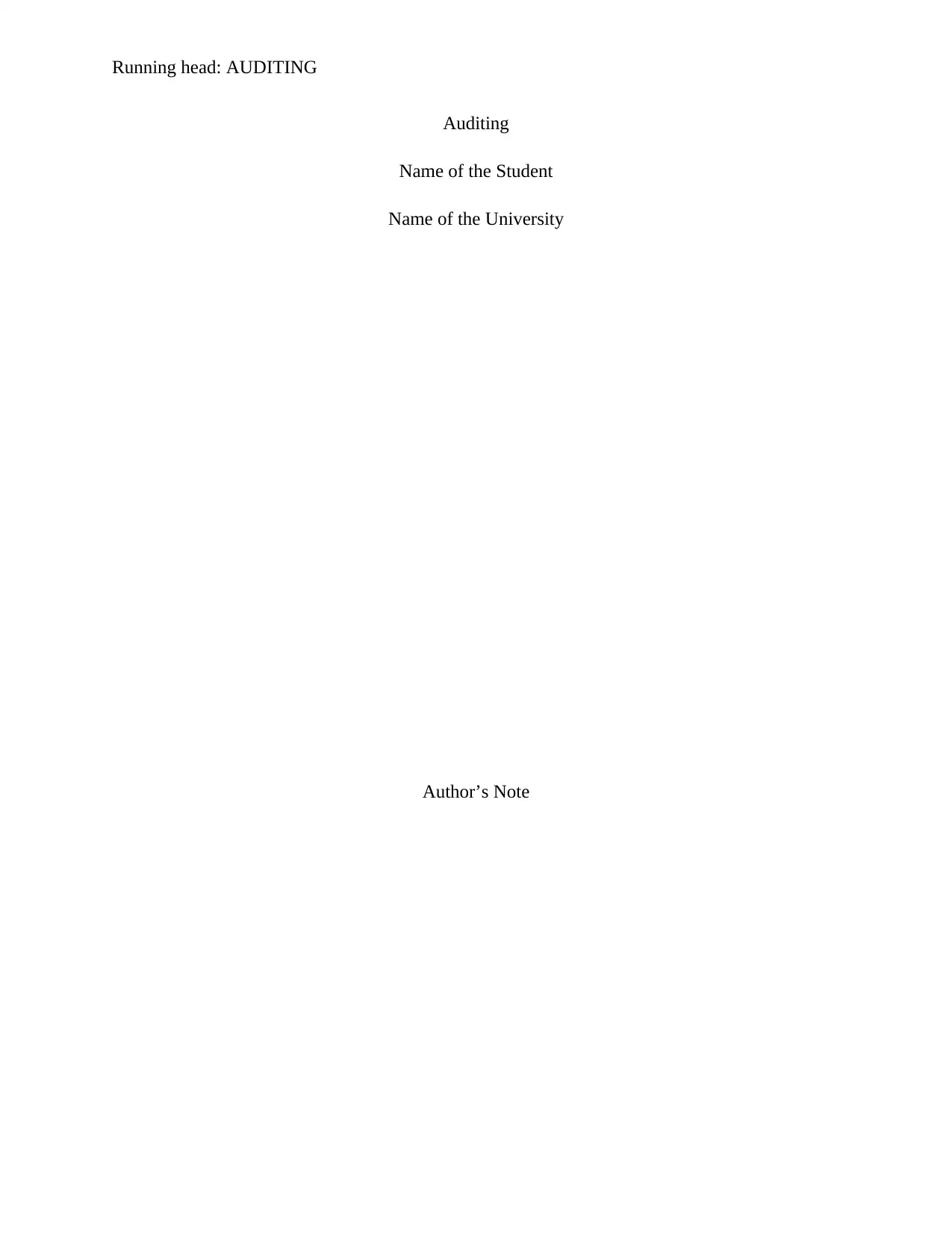
Running head: AUDITING
Auditing
Name of the Student
Name of the University
Author’s Note
Auditing
Name of the Student
Name of the University
Author’s Note
Paraphrase This Document
Need a fresh take? Get an instant paraphrase of this document with our AI Paraphraser
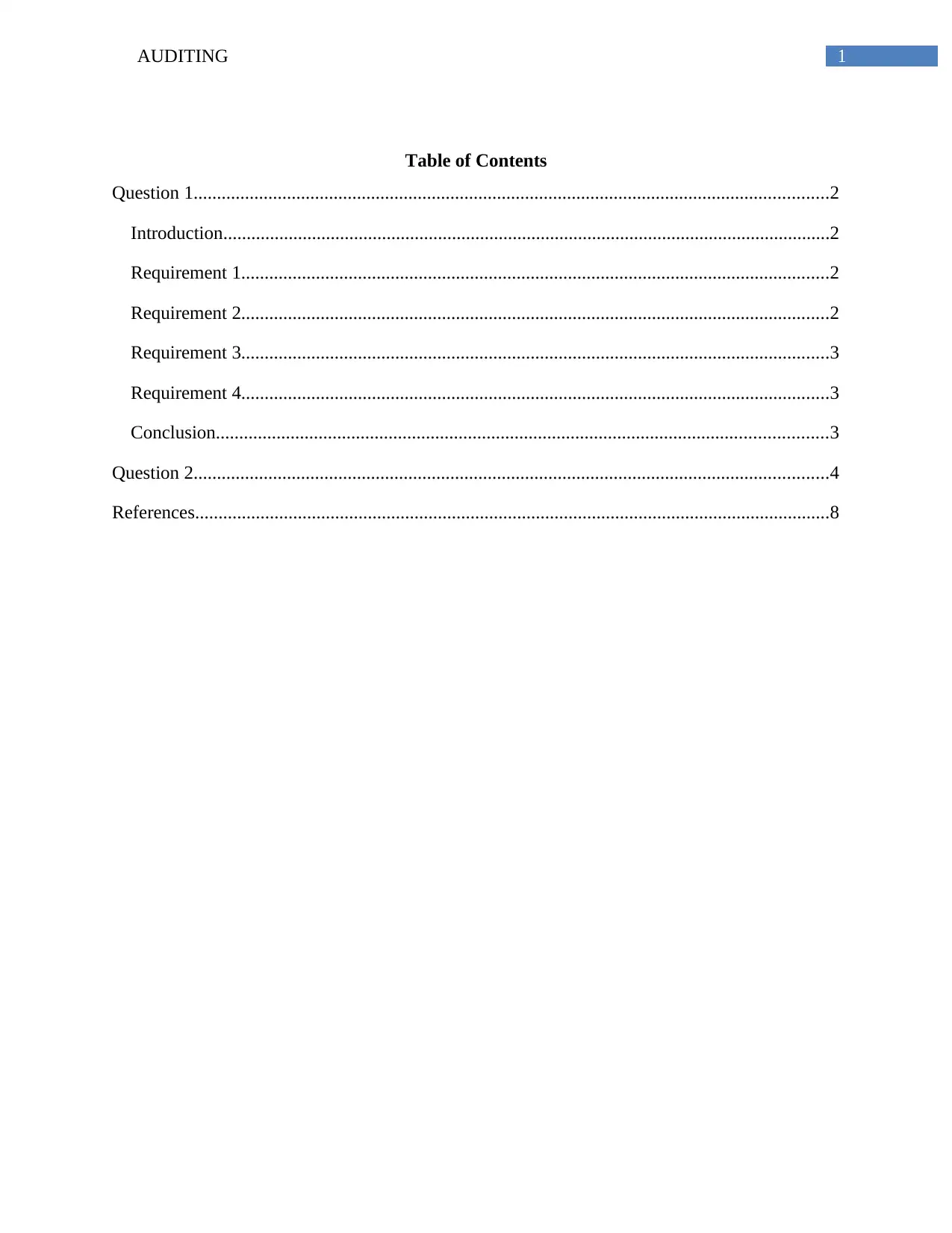
1AUDITING
Table of Contents
Question 1........................................................................................................................................2
Introduction..................................................................................................................................2
Requirement 1..............................................................................................................................2
Requirement 2..............................................................................................................................2
Requirement 3..............................................................................................................................3
Requirement 4..............................................................................................................................3
Conclusion...................................................................................................................................3
Question 2........................................................................................................................................4
References........................................................................................................................................8
Table of Contents
Question 1........................................................................................................................................2
Introduction..................................................................................................................................2
Requirement 1..............................................................................................................................2
Requirement 2..............................................................................................................................2
Requirement 3..............................................................................................................................3
Requirement 4..............................................................................................................................3
Conclusion...................................................................................................................................3
Question 2........................................................................................................................................4
References........................................................................................................................................8
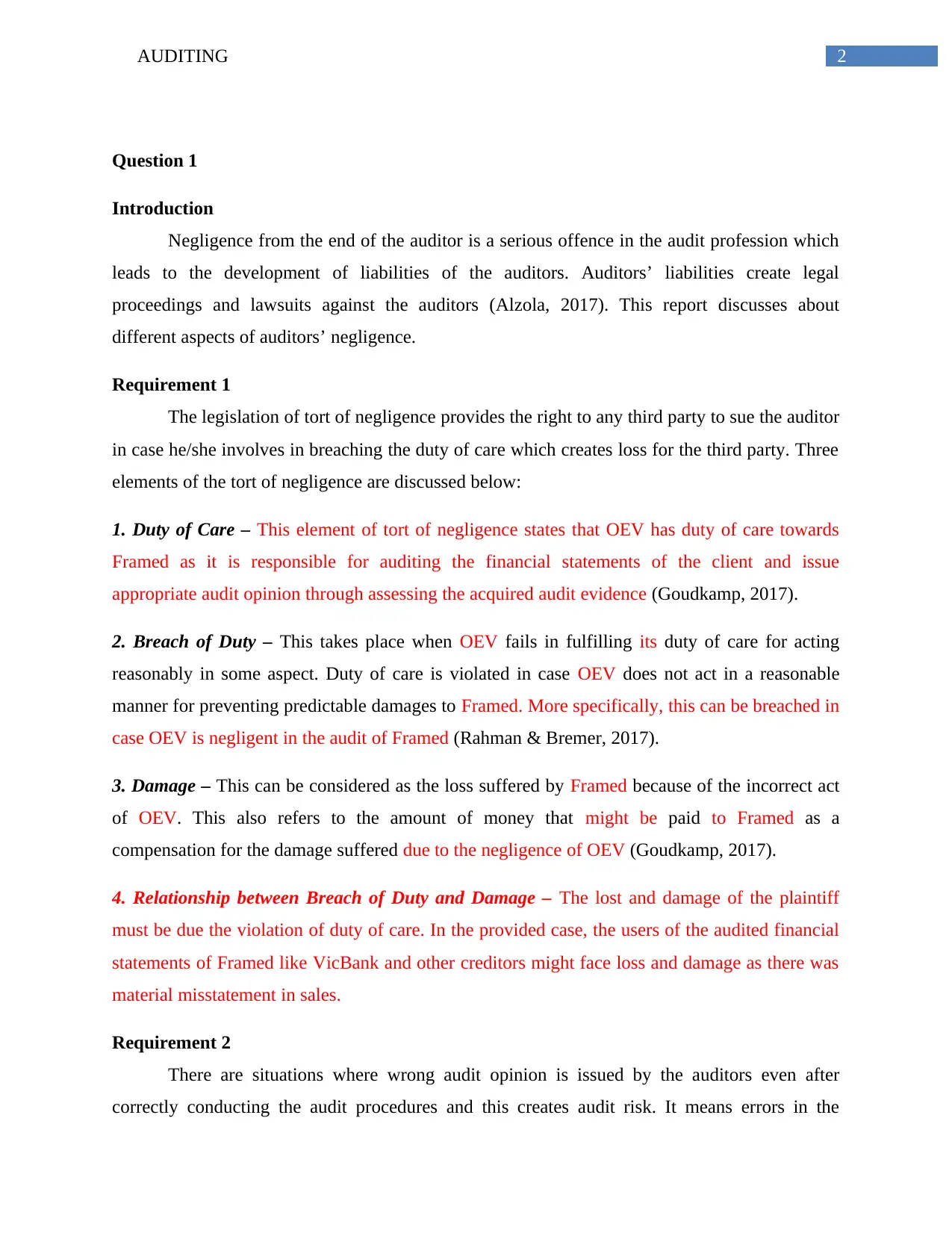
2AUDITING
Question 1
Introduction
Negligence from the end of the auditor is a serious offence in the audit profession which
leads to the development of liabilities of the auditors. Auditors’ liabilities create legal
proceedings and lawsuits against the auditors (Alzola, 2017). This report discusses about
different aspects of auditors’ negligence.
Requirement 1
The legislation of tort of negligence provides the right to any third party to sue the auditor
in case he/she involves in breaching the duty of care which creates loss for the third party. Three
elements of the tort of negligence are discussed below:
1. Duty of Care – This element of tort of negligence states that OEV has duty of care towards
Framed as it is responsible for auditing the financial statements of the client and issue
appropriate audit opinion through assessing the acquired audit evidence (Goudkamp, 2017).
2. Breach of Duty – This takes place when OEV fails in fulfilling its duty of care for acting
reasonably in some aspect. Duty of care is violated in case OEV does not act in a reasonable
manner for preventing predictable damages to Framed. More specifically, this can be breached in
case OEV is negligent in the audit of Framed (Rahman & Bremer, 2017).
3. Damage – This can be considered as the loss suffered by Framed because of the incorrect act
of OEV. This also refers to the amount of money that might be paid to Framed as a
compensation for the damage suffered due to the negligence of OEV (Goudkamp, 2017).
4. Relationship between Breach of Duty and Damage – The lost and damage of the plaintiff
must be due the violation of duty of care. In the provided case, the users of the audited financial
statements of Framed like VicBank and other creditors might face loss and damage as there was
material misstatement in sales.
Requirement 2
There are situations where wrong audit opinion is issued by the auditors even after
correctly conducting the audit procedures and this creates audit risk. It means errors in the
Question 1
Introduction
Negligence from the end of the auditor is a serious offence in the audit profession which
leads to the development of liabilities of the auditors. Auditors’ liabilities create legal
proceedings and lawsuits against the auditors (Alzola, 2017). This report discusses about
different aspects of auditors’ negligence.
Requirement 1
The legislation of tort of negligence provides the right to any third party to sue the auditor
in case he/she involves in breaching the duty of care which creates loss for the third party. Three
elements of the tort of negligence are discussed below:
1. Duty of Care – This element of tort of negligence states that OEV has duty of care towards
Framed as it is responsible for auditing the financial statements of the client and issue
appropriate audit opinion through assessing the acquired audit evidence (Goudkamp, 2017).
2. Breach of Duty – This takes place when OEV fails in fulfilling its duty of care for acting
reasonably in some aspect. Duty of care is violated in case OEV does not act in a reasonable
manner for preventing predictable damages to Framed. More specifically, this can be breached in
case OEV is negligent in the audit of Framed (Rahman & Bremer, 2017).
3. Damage – This can be considered as the loss suffered by Framed because of the incorrect act
of OEV. This also refers to the amount of money that might be paid to Framed as a
compensation for the damage suffered due to the negligence of OEV (Goudkamp, 2017).
4. Relationship between Breach of Duty and Damage – The lost and damage of the plaintiff
must be due the violation of duty of care. In the provided case, the users of the audited financial
statements of Framed like VicBank and other creditors might face loss and damage as there was
material misstatement in sales.
Requirement 2
There are situations where wrong audit opinion is issued by the auditors even after
correctly conducting the audit procedures and this creates audit risk. It means errors in the
⊘ This is a preview!⊘
Do you want full access?
Subscribe today to unlock all pages.

Trusted by 1+ million students worldwide
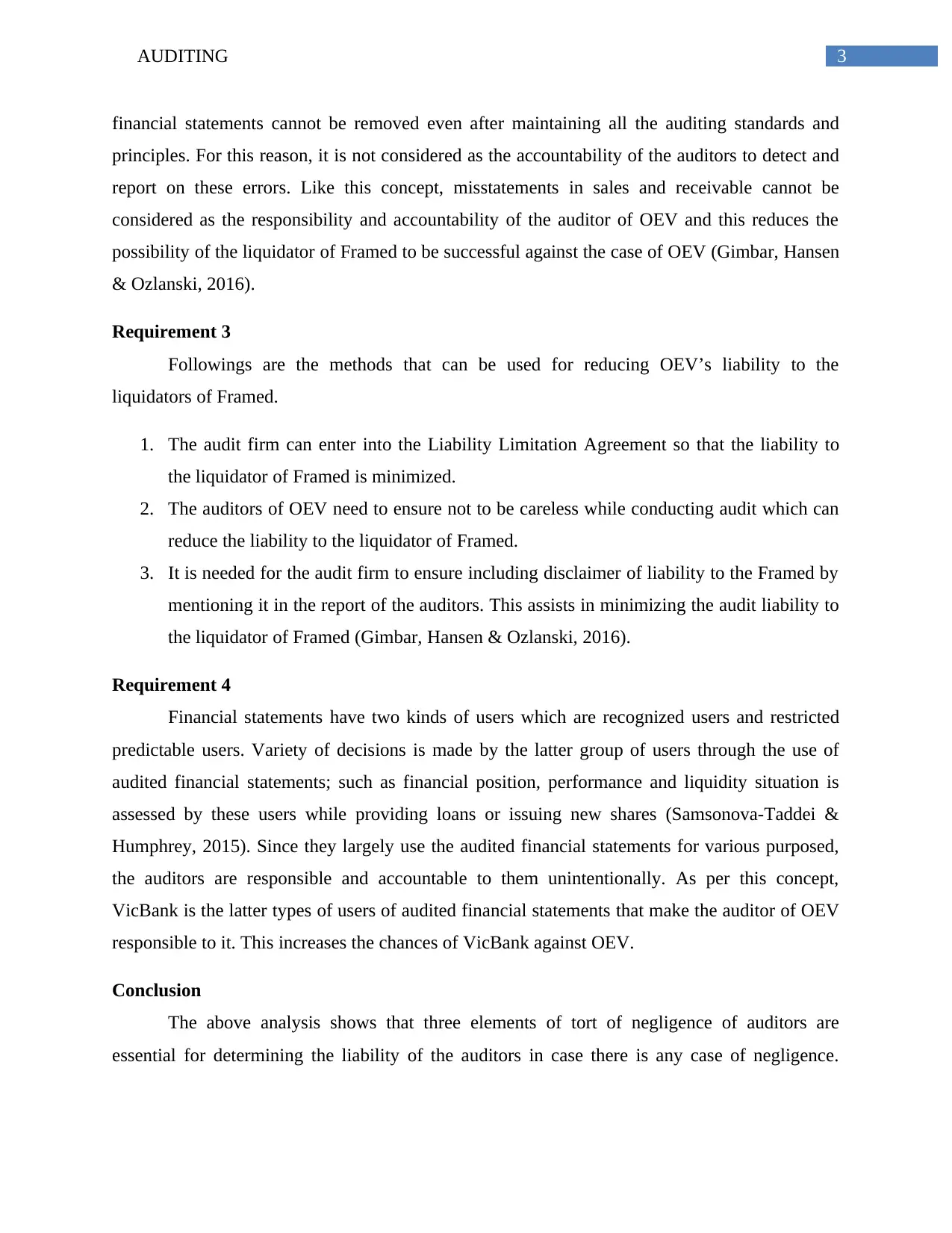
3AUDITING
financial statements cannot be removed even after maintaining all the auditing standards and
principles. For this reason, it is not considered as the accountability of the auditors to detect and
report on these errors. Like this concept, misstatements in sales and receivable cannot be
considered as the responsibility and accountability of the auditor of OEV and this reduces the
possibility of the liquidator of Framed to be successful against the case of OEV (Gimbar, Hansen
& Ozlanski, 2016).
Requirement 3
Followings are the methods that can be used for reducing OEV’s liability to the
liquidators of Framed.
1. The audit firm can enter into the Liability Limitation Agreement so that the liability to
the liquidator of Framed is minimized.
2. The auditors of OEV need to ensure not to be careless while conducting audit which can
reduce the liability to the liquidator of Framed.
3. It is needed for the audit firm to ensure including disclaimer of liability to the Framed by
mentioning it in the report of the auditors. This assists in minimizing the audit liability to
the liquidator of Framed (Gimbar, Hansen & Ozlanski, 2016).
Requirement 4
Financial statements have two kinds of users which are recognized users and restricted
predictable users. Variety of decisions is made by the latter group of users through the use of
audited financial statements; such as financial position, performance and liquidity situation is
assessed by these users while providing loans or issuing new shares (Samsonova-Taddei &
Humphrey, 2015). Since they largely use the audited financial statements for various purposed,
the auditors are responsible and accountable to them unintentionally. As per this concept,
VicBank is the latter types of users of audited financial statements that make the auditor of OEV
responsible to it. This increases the chances of VicBank against OEV.
Conclusion
The above analysis shows that three elements of tort of negligence of auditors are
essential for determining the liability of the auditors in case there is any case of negligence.
financial statements cannot be removed even after maintaining all the auditing standards and
principles. For this reason, it is not considered as the accountability of the auditors to detect and
report on these errors. Like this concept, misstatements in sales and receivable cannot be
considered as the responsibility and accountability of the auditor of OEV and this reduces the
possibility of the liquidator of Framed to be successful against the case of OEV (Gimbar, Hansen
& Ozlanski, 2016).
Requirement 3
Followings are the methods that can be used for reducing OEV’s liability to the
liquidators of Framed.
1. The audit firm can enter into the Liability Limitation Agreement so that the liability to
the liquidator of Framed is minimized.
2. The auditors of OEV need to ensure not to be careless while conducting audit which can
reduce the liability to the liquidator of Framed.
3. It is needed for the audit firm to ensure including disclaimer of liability to the Framed by
mentioning it in the report of the auditors. This assists in minimizing the audit liability to
the liquidator of Framed (Gimbar, Hansen & Ozlanski, 2016).
Requirement 4
Financial statements have two kinds of users which are recognized users and restricted
predictable users. Variety of decisions is made by the latter group of users through the use of
audited financial statements; such as financial position, performance and liquidity situation is
assessed by these users while providing loans or issuing new shares (Samsonova-Taddei &
Humphrey, 2015). Since they largely use the audited financial statements for various purposed,
the auditors are responsible and accountable to them unintentionally. As per this concept,
VicBank is the latter types of users of audited financial statements that make the auditor of OEV
responsible to it. This increases the chances of VicBank against OEV.
Conclusion
The above analysis shows that three elements of tort of negligence of auditors are
essential for determining the liability of the auditors in case there is any case of negligence.
Paraphrase This Document
Need a fresh take? Get an instant paraphrase of this document with our AI Paraphraser
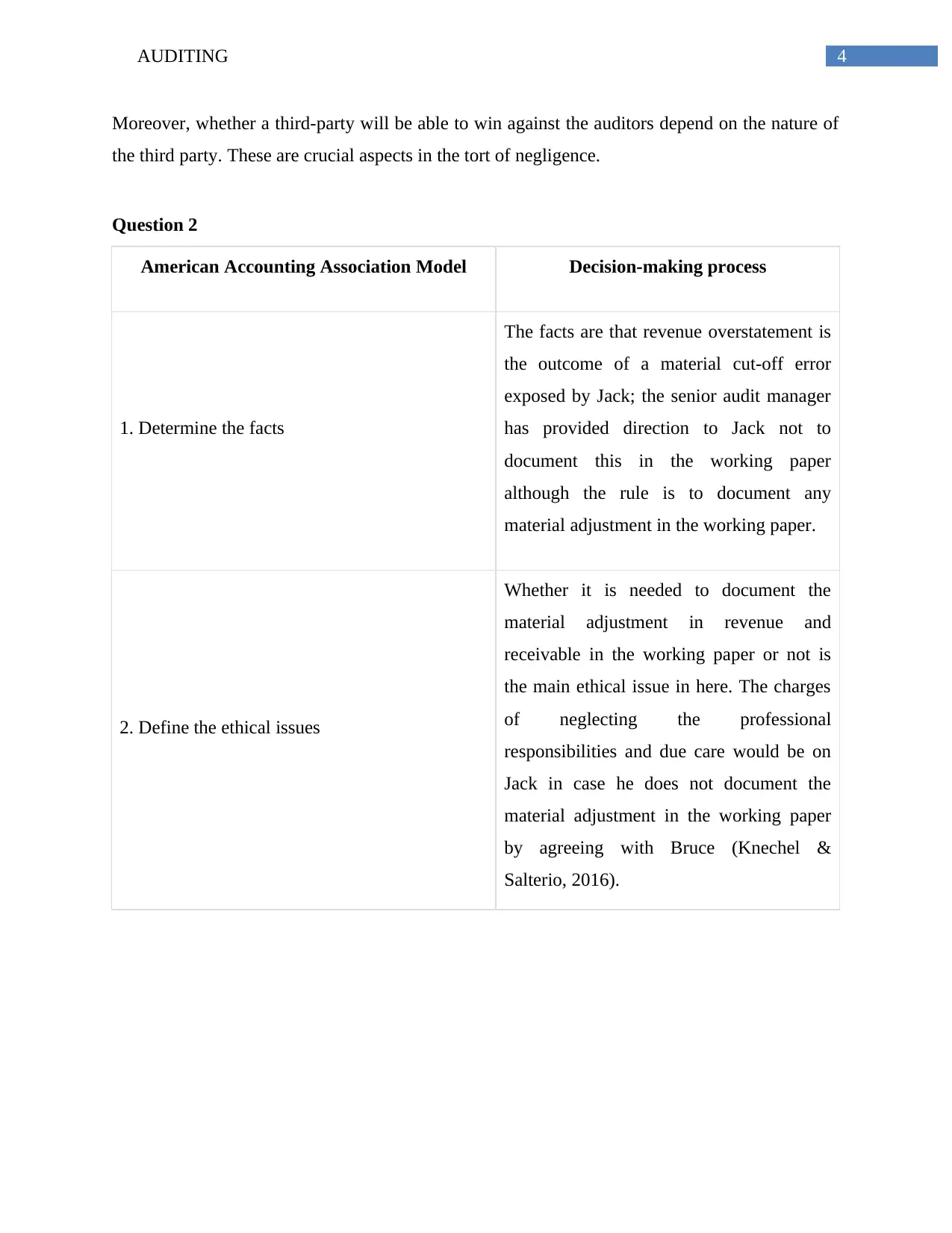
4AUDITING
Moreover, whether a third-party will be able to win against the auditors depend on the nature of
the third party. These are crucial aspects in the tort of negligence.
Question 2
American Accounting Association Model Decision-making process
1. Determine the facts
The facts are that revenue overstatement is
the outcome of a material cut-off error
exposed by Jack; the senior audit manager
has provided direction to Jack not to
document this in the working paper
although the rule is to document any
material adjustment in the working paper.
2. Define the ethical issues
Whether it is needed to document the
material adjustment in revenue and
receivable in the working paper or not is
the main ethical issue in here. The charges
of neglecting the professional
responsibilities and due care would be on
Jack in case he does not document the
material adjustment in the working paper
by agreeing with Bruce (Knechel &
Salterio, 2016).
Moreover, whether a third-party will be able to win against the auditors depend on the nature of
the third party. These are crucial aspects in the tort of negligence.
Question 2
American Accounting Association Model Decision-making process
1. Determine the facts
The facts are that revenue overstatement is
the outcome of a material cut-off error
exposed by Jack; the senior audit manager
has provided direction to Jack not to
document this in the working paper
although the rule is to document any
material adjustment in the working paper.
2. Define the ethical issues
Whether it is needed to document the
material adjustment in revenue and
receivable in the working paper or not is
the main ethical issue in here. The charges
of neglecting the professional
responsibilities and due care would be on
Jack in case he does not document the
material adjustment in the working paper
by agreeing with Bruce (Knechel &
Salterio, 2016).
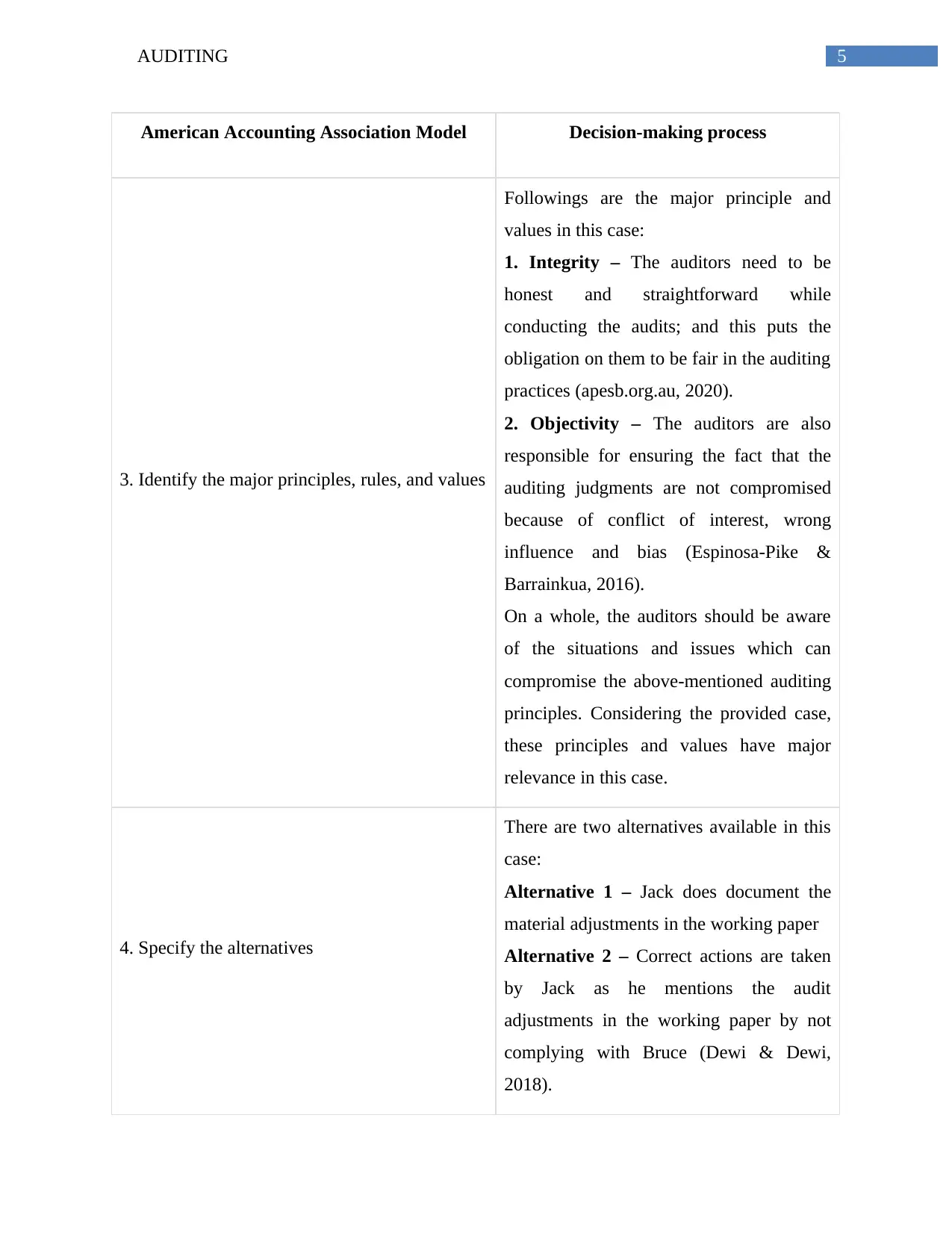
5AUDITING
American Accounting Association Model Decision-making process
3. Identify the major principles, rules, and values
Followings are the major principle and
values in this case:
1. Integrity – The auditors need to be
honest and straightforward while
conducting the audits; and this puts the
obligation on them to be fair in the auditing
practices (apesb.org.au, 2020).
2. Objectivity – The auditors are also
responsible for ensuring the fact that the
auditing judgments are not compromised
because of conflict of interest, wrong
influence and bias (Espinosa-Pike &
Barrainkua, 2016).
On a whole, the auditors should be aware
of the situations and issues which can
compromise the above-mentioned auditing
principles. Considering the provided case,
these principles and values have major
relevance in this case.
4. Specify the alternatives
There are two alternatives available in this
case:
Alternative 1 – Jack does document the
material adjustments in the working paper
Alternative 2 – Correct actions are taken
by Jack as he mentions the audit
adjustments in the working paper by not
complying with Bruce (Dewi & Dewi,
2018).
American Accounting Association Model Decision-making process
3. Identify the major principles, rules, and values
Followings are the major principle and
values in this case:
1. Integrity – The auditors need to be
honest and straightforward while
conducting the audits; and this puts the
obligation on them to be fair in the auditing
practices (apesb.org.au, 2020).
2. Objectivity – The auditors are also
responsible for ensuring the fact that the
auditing judgments are not compromised
because of conflict of interest, wrong
influence and bias (Espinosa-Pike &
Barrainkua, 2016).
On a whole, the auditors should be aware
of the situations and issues which can
compromise the above-mentioned auditing
principles. Considering the provided case,
these principles and values have major
relevance in this case.
4. Specify the alternatives
There are two alternatives available in this
case:
Alternative 1 – Jack does document the
material adjustments in the working paper
Alternative 2 – Correct actions are taken
by Jack as he mentions the audit
adjustments in the working paper by not
complying with Bruce (Dewi & Dewi,
2018).
⊘ This is a preview!⊘
Do you want full access?
Subscribe today to unlock all pages.

Trusted by 1+ million students worldwide

6AUDITING
American Accounting Association Model Decision-making process
5. Compare values and alternatives
Both integrity and objectivity are the key
principles and values in this case and both
of these principles and values would be
violated in case the audit adjustments are
not mentioned by Jack in the working
paper. On the other hand, it would be
possible for Jack not to violate these key
principles and values by documenting the
material adjustments in the working paper
while not complying with the proposal of
Bruce. In this manner, it would be possible
to additionally consider the areas like
overstatement in revenue and receivable for
more extensive audit work (Knechel &
Salterio, 2016).
6. Assess the consequences Alternative 1 – It would be possible for
the audit firm in retaining the audit of
Switch Pty Ltd by not documenting the
material adjustments in the working paper
which would provide favorable audit
outcome. However, this wrongdoing of
Jack can put him into professional and
legal problem as he would have violated
the auditing principles. This ethical
dilemma will be with him for long time
(Knechel & Salterio, 2016).
Alternative 2 – This particular alternative
would deter Jack in accepting the order of
American Accounting Association Model Decision-making process
5. Compare values and alternatives
Both integrity and objectivity are the key
principles and values in this case and both
of these principles and values would be
violated in case the audit adjustments are
not mentioned by Jack in the working
paper. On the other hand, it would be
possible for Jack not to violate these key
principles and values by documenting the
material adjustments in the working paper
while not complying with the proposal of
Bruce. In this manner, it would be possible
to additionally consider the areas like
overstatement in revenue and receivable for
more extensive audit work (Knechel &
Salterio, 2016).
6. Assess the consequences Alternative 1 – It would be possible for
the audit firm in retaining the audit of
Switch Pty Ltd by not documenting the
material adjustments in the working paper
which would provide favorable audit
outcome. However, this wrongdoing of
Jack can put him into professional and
legal problem as he would have violated
the auditing principles. This ethical
dilemma will be with him for long time
(Knechel & Salterio, 2016).
Alternative 2 – This particular alternative
would deter Jack in accepting the order of
Paraphrase This Document
Need a fresh take? Get an instant paraphrase of this document with our AI Paraphraser
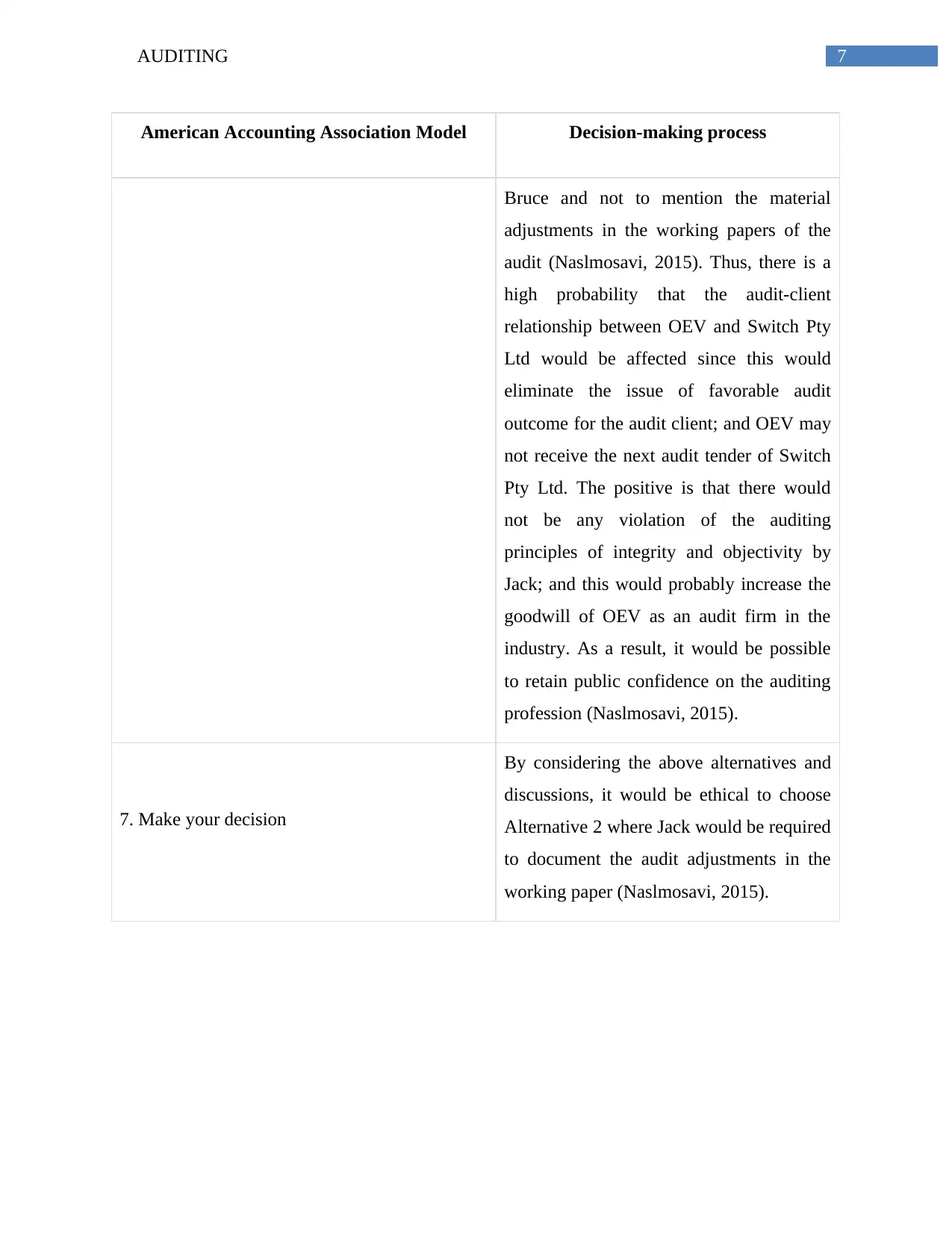
7AUDITING
American Accounting Association Model Decision-making process
Bruce and not to mention the material
adjustments in the working papers of the
audit (Naslmosavi, 2015). Thus, there is a
high probability that the audit-client
relationship between OEV and Switch Pty
Ltd would be affected since this would
eliminate the issue of favorable audit
outcome for the audit client; and OEV may
not receive the next audit tender of Switch
Pty Ltd. The positive is that there would
not be any violation of the auditing
principles of integrity and objectivity by
Jack; and this would probably increase the
goodwill of OEV as an audit firm in the
industry. As a result, it would be possible
to retain public confidence on the auditing
profession (Naslmosavi, 2015).
7. Make your decision
By considering the above alternatives and
discussions, it would be ethical to choose
Alternative 2 where Jack would be required
to document the audit adjustments in the
working paper (Naslmosavi, 2015).
American Accounting Association Model Decision-making process
Bruce and not to mention the material
adjustments in the working papers of the
audit (Naslmosavi, 2015). Thus, there is a
high probability that the audit-client
relationship between OEV and Switch Pty
Ltd would be affected since this would
eliminate the issue of favorable audit
outcome for the audit client; and OEV may
not receive the next audit tender of Switch
Pty Ltd. The positive is that there would
not be any violation of the auditing
principles of integrity and objectivity by
Jack; and this would probably increase the
goodwill of OEV as an audit firm in the
industry. As a result, it would be possible
to retain public confidence on the auditing
profession (Naslmosavi, 2015).
7. Make your decision
By considering the above alternatives and
discussions, it would be ethical to choose
Alternative 2 where Jack would be required
to document the audit adjustments in the
working paper (Naslmosavi, 2015).

8AUDITING
References
Alzola, M. (2017). Beware of the watchdog: Rethinking the normative justification of gatekeeper
liability. Journal of business ethics, 140(4), 705-721.
Apesb.org.au. (2020). APES 110 Code of Ethics for Professional Accountants (including
Independence Standards). Retrieved 18 March 2020, from
https://www.apesb.org.au/uploads/home/02112018000152_APES_110_Restructured_Co
de_Nov_2018.pdf
ARDELEAN, A. (2015). Study regarding the Clarification of Ethical Dilemmas in Financial
Audit. Audit Financiar, 13(125).
Dewi, I. G. A. A. P., & Dewi, P. P. (2018). Big Five Personality, Ethical Sensitivity, and
Performance of Auditors. International research journal of management, IT and social
sciences, 5(2), 195-209.
Espinosa-Pike, M., & Barrainkua, I. (2016). An exploratory study of the pressures and ethical
dilemmas in the audit conflict. Revista de Contabilidad, 19(1), 10-20.
Gimbar, C., Hansen, B., & Ozlanski, M. E. (2016). Early evidence on the effects of critical audit
matters on auditor liability. Current Issues in Auditing, 10(1), A24-A33.
Gimbar, C., Hansen, B., & Ozlanski, M. E. (2016). The effects of critical audit matter paragraphs
and accounting standard precision on auditor liability. The Accounting Review, 91(6),
1629-1646.
Goudkamp, J. (2017). The contributory negligence doctrine: four commercial law
problems. Lloyd's Maritime and Commercial Law Quarterly, Forthcoming.
Knechel, W. R., & Salterio, S. E. (2016). Auditing: Assurance and risk. Taylor & Francis.
Naslmosavi, S. (2015). The Effect of Ethics on Auditor's Judgment in Ethical Dilemma
Conditions: Evidence from Iranian Auditors. Available at SSRN 2584308.
References
Alzola, M. (2017). Beware of the watchdog: Rethinking the normative justification of gatekeeper
liability. Journal of business ethics, 140(4), 705-721.
Apesb.org.au. (2020). APES 110 Code of Ethics for Professional Accountants (including
Independence Standards). Retrieved 18 March 2020, from
https://www.apesb.org.au/uploads/home/02112018000152_APES_110_Restructured_Co
de_Nov_2018.pdf
ARDELEAN, A. (2015). Study regarding the Clarification of Ethical Dilemmas in Financial
Audit. Audit Financiar, 13(125).
Dewi, I. G. A. A. P., & Dewi, P. P. (2018). Big Five Personality, Ethical Sensitivity, and
Performance of Auditors. International research journal of management, IT and social
sciences, 5(2), 195-209.
Espinosa-Pike, M., & Barrainkua, I. (2016). An exploratory study of the pressures and ethical
dilemmas in the audit conflict. Revista de Contabilidad, 19(1), 10-20.
Gimbar, C., Hansen, B., & Ozlanski, M. E. (2016). Early evidence on the effects of critical audit
matters on auditor liability. Current Issues in Auditing, 10(1), A24-A33.
Gimbar, C., Hansen, B., & Ozlanski, M. E. (2016). The effects of critical audit matter paragraphs
and accounting standard precision on auditor liability. The Accounting Review, 91(6),
1629-1646.
Goudkamp, J. (2017). The contributory negligence doctrine: four commercial law
problems. Lloyd's Maritime and Commercial Law Quarterly, Forthcoming.
Knechel, W. R., & Salterio, S. E. (2016). Auditing: Assurance and risk. Taylor & Francis.
Naslmosavi, S. (2015). The Effect of Ethics on Auditor's Judgment in Ethical Dilemma
Conditions: Evidence from Iranian Auditors. Available at SSRN 2584308.
⊘ This is a preview!⊘
Do you want full access?
Subscribe today to unlock all pages.

Trusted by 1+ million students worldwide
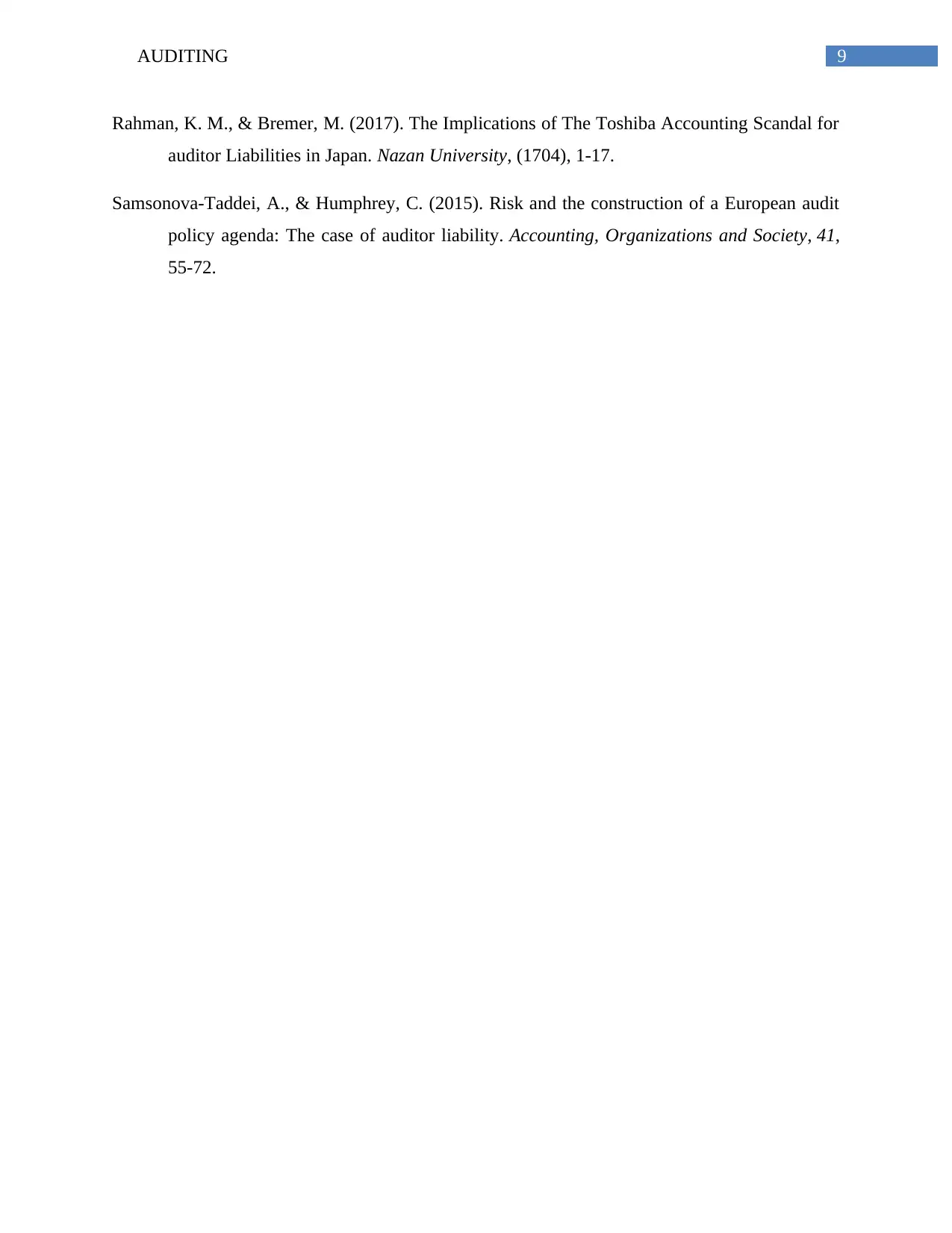
9AUDITING
Rahman, K. M., & Bremer, M. (2017). The Implications of The Toshiba Accounting Scandal for
auditor Liabilities in Japan. Nazan University, (1704), 1-17.
Samsonova-Taddei, A., & Humphrey, C. (2015). Risk and the construction of a European audit
policy agenda: The case of auditor liability. Accounting, Organizations and Society, 41,
55-72.
Rahman, K. M., & Bremer, M. (2017). The Implications of The Toshiba Accounting Scandal for
auditor Liabilities in Japan. Nazan University, (1704), 1-17.
Samsonova-Taddei, A., & Humphrey, C. (2015). Risk and the construction of a European audit
policy agenda: The case of auditor liability. Accounting, Organizations and Society, 41,
55-72.
1 out of 10
Related Documents
Your All-in-One AI-Powered Toolkit for Academic Success.
+13062052269
info@desklib.com
Available 24*7 on WhatsApp / Email
![[object Object]](/_next/static/media/star-bottom.7253800d.svg)
Unlock your academic potential
© 2024 | Zucol Services PVT LTD | All rights reserved.





